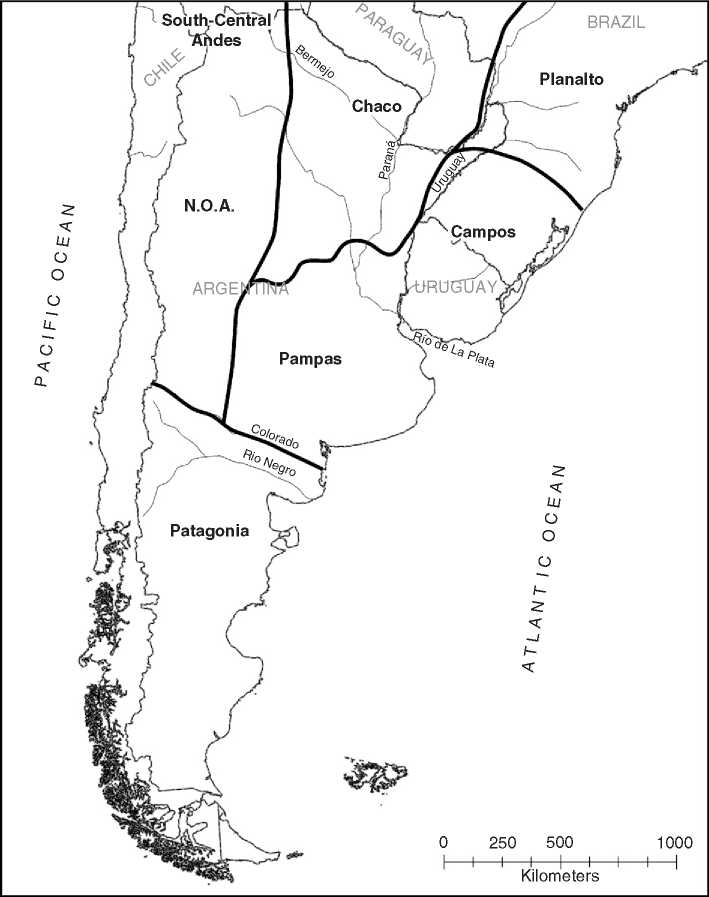The earliest secure evidence for human occupation of the region east of the Andes is the open-air site of Arroyo Seco 2 (Figure 2), where initial occupation dates to c. 12 200 years BP. A large number of sites have been detected in the pampas especially in the Tandilia mountain range (Cueva Tixi, Cerro La China, Cerro El Sombrero, etc.). These sites are small caves or rockshelters with an early component in association with fishtail projectile points (Figure 3). These sites have been consistently dated between 10 000 and 11 000 years BP. West of the cordillera, the oldest evidence of human occupation is at the Monte Verde site, dated between c. 12 300 and 12 800 years BP. This component has been interpreted as a forest-adapted economy, based primarily on the collection of wild plant foods and secondarily on the scavenging and/or hunting of large and small animals. Both Monte Verde and Arroyo Seco 2 sites indicate that humans were in the Southern Cone on both sides of the Andes reaching south of 38° south latitude before 12 000 years BP. Moreover, a number of sites in the pampas as well as in the Cordillera and in the Central Valley of Chile (such as Tagua-Tagua) indicate that humans were well established in this latitudinal belt between 10 500 and 11 000 years BP.
In the Patagonian plateau, the oldest secure group of dates come from archaeological sites in rockshel-ters and caves the Rio Deseado basin (Los Toldos, Piedra Museo, El Ceibo, Cerro Tres Tetas, etc.). These sites indicate a human presence in the 47° to 50° latitudes around 11 000 years BP. At the end of the Pleistocene in the southern tip of Patagonia, the South American mainland and the island of Tierra del Fuego were connected and formed a continuous mass of land. This area was occupied roughly at the same time, indicating that humans arrived shortly after de-glaciations, at c. 10500 to 11 000 years BP. In this area, fishtail projectile point was also a distinctive tool in many sites (Fell’s Cave, Palli Aike, Cueva del Medio, etc.).
In the campos of Uruguay, the occupation of early hunter-gatherers has been dated c. 11 000 years BP. All reported sites are open-air sites located in three areas: the Uruguay-Cuareim River, the middle basin of the Rio Negro, and the Atlantic Coast. During the Late Pleistocene, the campos of Uruguay and the pampas of Argentina shared several common features, such as the fishtail projectile point technology and other technological traits (i. e., reduction sequences, type of lithic raw material). This suggests some kind of relationship or shared knowledge between these two sub-regions. In the Brazilian campos, the sequence of hunter-gatherer occupation known as the Umbu Tradition began with the Uruguai Phase and dates between c. 10 800 and 8500 years BP. In terms of technology, small bifacial stemmed chalcedony projectile points associated with side and end scrapers, retouched flakes, and unipolar and bipolar (flaked in both ends) artifacts made on basalt, chalcedony, quartz, and chert are typical.
During the Late Pleistocene and into the Early Holocene, a variety of herbivores were hunted by early foragers in the region. Among them, guanaco (Lama guanicoe) was the main resource in the pampas, Patagonia, and in the Andean Cordillera, while deer (Ozotoceros and Blastoceros) was principally

Figure 1 Map with the main areas of the Southern Cone.
Hunted in the campos. Extinct megafauna such as giant ground sloth, ground sloth, extinct horse, and glyptodonts were secondary or occasional resources in the pampas and in Patagonia. West of the cordillera, mastodon and extinct species of horse were hunted and consumed. The timing and cause of Pleistocene fauna extinction are still part of an open debate, although increasing data from pampas sites suggest the survival of some species until the Early Holocene (between c. 7000 and 8000 years BP). It is likely that the impact of early foragers on large herbivores, not only by hunting but also by fires in the grasslands and forests, would accelerate this process of extinction.
At the end of the Early Holocene, pampas hunter-gatherers began to exploit marine resources and to
Occupy, at least seasonally, the Atlantic coast. The first evidence came from the La Olla 1 and 2 sites (i. e., seal processing loci) and the Monte Hermoso 1 site (with human footprints) which date between 6640 and 7920 years BP and are located on the Atlantic coast. At c. 6000 years BP, the first evidence of marine adaptation is recorded in southern Patagonia in the Beagle Channel (the Tunel site), where shell middens have been found.




 World History
World History









